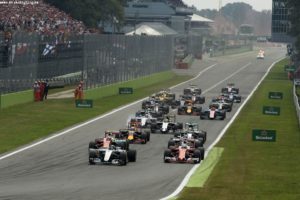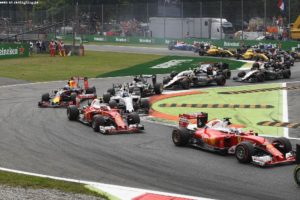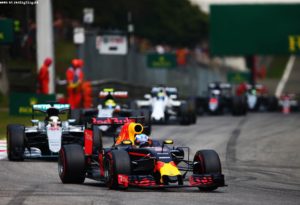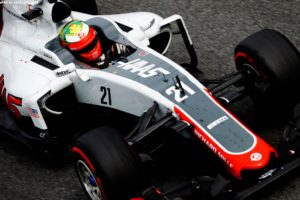It doesn’t happen often that a Formula 1 Grand Prix is won on a Saturday, but that was the case with this Italian Grand Prix. Mercedes took the opportunity to qualify on Soft tyres, rather than SuperSofts, so they could start the race on them and do a one-stop strategy. No one else did this.
 Was that something that Ferrari and Red Bull could have managed also? And if they had, would they have been able to get a better result, given that Lewis Hamilton messed up his start and fell to 6th place on the opening lap? And even after Red Bull opted against it, could Daniel Ricciardo still have raced the Ferraris instead of Valtteri Bottas’ Williams with better strategy?Monza has traditionally been a one-stop race, as the relative pace of the cars out on track at 360km/h compared to those travelling at 80km/h in the pit lane, makes it less attractive to do more stops.
Was that something that Ferrari and Red Bull could have managed also? And if they had, would they have been able to get a better result, given that Lewis Hamilton messed up his start and fell to 6th place on the opening lap? And even after Red Bull opted against it, could Daniel Ricciardo still have raced the Ferraris instead of Valtteri Bottas’ Williams with better strategy?Monza has traditionally been a one-stop race, as the relative pace of the cars out on track at 360km/h compared to those travelling at 80km/h in the pit lane, makes it less attractive to do more stops.
This year Pirelli brought the supersoft tyre in addition to the soft and mediums used last year. Many drivers managed the 53-lap race with one stop in 2015, starting on the soft and switching to the mediums around Lap 19/20. But the supersoft was around 0.8secs faster than the soft so many drivers wanted to take it for qualifying, even if it would mean a shorter first stint than on soft.
The top three teams, Mercedes, Red Bull and Ferrari all knew this would be a crucial decision and spent time evaluating the soft and supersoft tyres during practice.
Ferrari and Red Bull avoid the risk
It is very easy after the event to look back and see how teams could have got a better result from a different strategy. It was as clear as day from Friday onwards that Mercedes was going to go for a one stop soft-medium strategy. They had the pace and they are always able to make the medium tyre work.
So there were several considerations for Ferrari and Red Bull, which appeared to be around half a second a lap slower than the Mercedes. Could they accept the risk of qualifying on softs in Q2 and ending up outside the Top 10 if it went wrong?
In Ferrari’s case, at their home Grand Prix with chairman Sergio Marchionne there on Saturday telling the press an hour before qualifying that the team had failed this year, was that an incentive to take bold risks or a dampener, which made them risk averse?
 Ferrari used a set of softs in Q1, (a tactic which also saved both drivers a new set of supersofts for the race) to get an indication of whether it would be possible to get through Q2. Vettel did a 1m 23.077s and Raikkonen a 1m 23.217s. The prediction after Q1 was that the cut off time to get into the Top 10 would be 1m 22.9s. Allowing for track improvement of 0.2s and some driver improvement due to familiarity with the same tyre compound, Ferrari could be confident that they’d be at least 0.2 to 0.3s inside the cut off.
Ferrari used a set of softs in Q1, (a tactic which also saved both drivers a new set of supersofts for the race) to get an indication of whether it would be possible to get through Q2. Vettel did a 1m 23.077s and Raikkonen a 1m 23.217s. The prediction after Q1 was that the cut off time to get into the Top 10 would be 1m 22.9s. Allowing for track improvement of 0.2s and some driver improvement due to familiarity with the same tyre compound, Ferrari could be confident that they’d be at least 0.2 to 0.3s inside the cut off.
But both drivers have made mistakes in qualifying recently, especially Raikkonen, so there was risk there too. It would be tight. In the event the cut-off prediction was correct; it was Hulkenberg’s 1m 22.951s. Ferrari would have made it. But they did not go for it. Part of this may well also have been a fear of using the medium tyre.
Neither did Red Bull, who were a little slower than Ferrari in Monza, although they did at least have a look at running soft in Q2. Ricciardo’s 1m23.004s run was right on the limit. Verstappen did 1m 23.096s. Rather than go for another run on softs they opted for the safe route and ran supersofts to be sure of making the top ten.
But there was a wider consideration, for Ferrari at least; how likely was it that one of the Mercedes would make a poor start in the race? It had happened six times already this season, so the probability was quite high. It happened again as the world champion fell to sixth, behind both Ferraris and both Red Bulls. But they weren’t in a position to capitalise on the track position gift this gave them.
Ricciardo races the wrong car
Having found himself in this situation Daniel Ricciardo had quite a lonely afternoon, behind the Ferraris and having only to deal with the Williams of Bottas, but he brightened up an otherwise rather dull afternoon when he had to overtake Bottas late on. However the reality was that Red Bull made a mistake on strategy at his first stop, which cost him the chance to race Raikkonen for fourth, rather than Bottas for fifth.
 Ricciardo has shown exceptional ability to keep the tyres going this season and he managed to reach Lap 16 on his supersoft tyres, one lap after Raikkonen pitted. At this time his tyres were still performing and he was doing consistent mid 1m 28.4s laps. There was no pressure from behind so he had the luxury of trying something different.
Ricciardo has shown exceptional ability to keep the tyres going this season and he managed to reach Lap 16 on his supersoft tyres, one lap after Raikkonen pitted. At this time his tyres were still performing and he was doing consistent mid 1m 28.4s laps. There was no pressure from behind so he had the luxury of trying something different.
Had Red Bull left him out for two or three more laps he could have switched strategies onto a one stop and run the medium for the rest of the race. That would have put him ahead of Raikkonen on Lap 34 when the Ferrari made its second stop.
It is possible Raikkonen might have overtaken him before the end, but not a dead certainty, considering how hard the Finn has found passing Verstappen’s Red Bull in similar situations this year. Ricciardo would have been racing a Ferrari for fourth, rather than a Williams for fifth.
That said, once Red Bull missed that opportunity, they did well to leave him out longer on the second stint and take a supersoft for the final stint to attack Bottas. His pass was one of the best of the season so far.
Haas has a howler
 The Haas F1 team has had a pretty successful F1 debut season with four points-scoring races. They were well placed to add a fifth at the home of their technical partner Ferrari, with the new updates on the power unit giving them a boost. Guttierez qualified 10th, but dropped to 18th at the start, while Romain Grosjean was in a strong position behind Alonso and Hulkenberg but then the team basically went AWOL strategically.
The Haas F1 team has had a pretty successful F1 debut season with four points-scoring races. They were well placed to add a fifth at the home of their technical partner Ferrari, with the new updates on the power unit giving them a boost. Guttierez qualified 10th, but dropped to 18th at the start, while Romain Grosjean was in a strong position behind Alonso and Hulkenberg but then the team basically went AWOL strategically.
The Frenchman started the race on the soft tyres and stayed out on them far too long before pitting on Lap 28. He lost so much time as his lap times deteriorated on the worn tyres, that his rivals had almost a pit stop worth of time advantage over him, negating all reason for one stopping. And as Hulkenberg was two stopping, a chance went begging for the one stopping Haas driver to score another point for his team.


